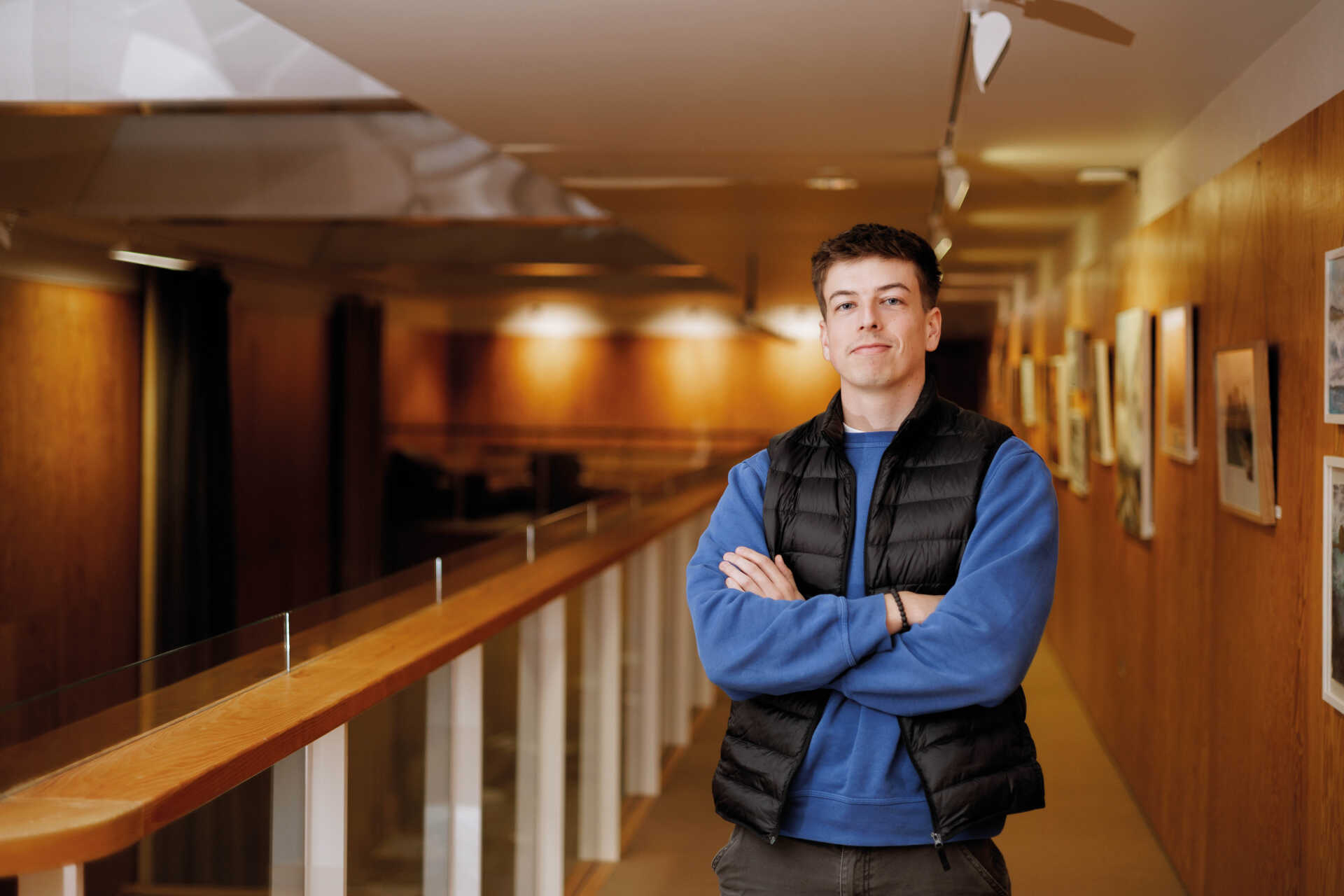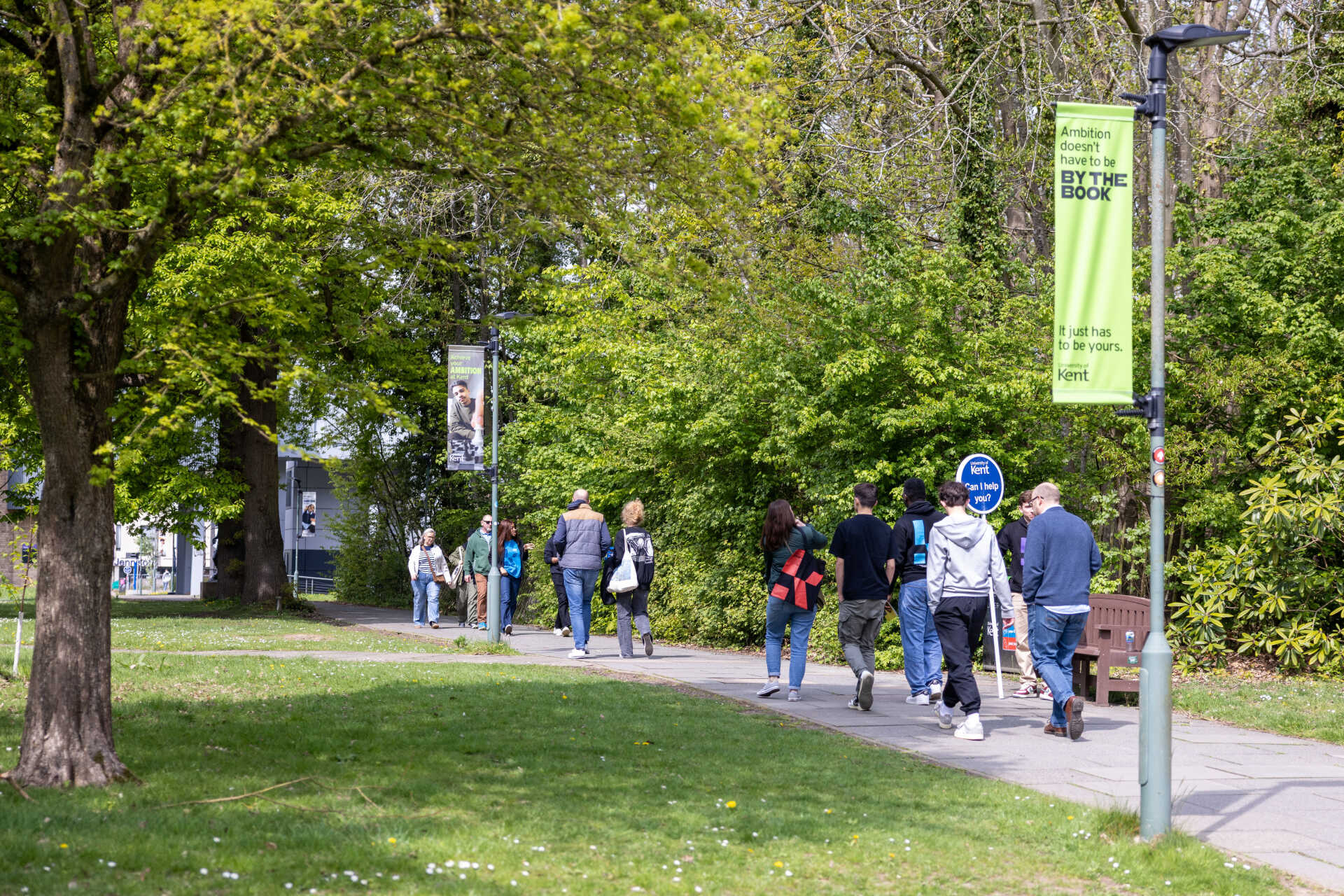Mathematics
with a Year in Industry
Learn how to apply mathematical principles to cutting-edge careers.
Key information

Learn how to apply mathematical principles to cutting-edge careers.

Maths isn’t just numbers and theory. It’s a key to unlocking your future.
The skills and ideas you’ll learn on this course are in demand in many exciting careers – from finance to computing, engineering, science and media.
At Kent, we focus on application as well as theory. We’ll give you a firm grounding in core principles such as algebra, probability and statistics. But you’ll also learn how you can solve real-world challenges with machine learning, data analysis, cryptography, numerical methods and optimisation techniques.
Through experiential learning and industry-led projects, we’ll challenge you to apply what you learn - and help you develop in-demand skills such as programming, technical writing, communication, and problem-solving.
Mathematicians today are playing pivotal roles in tackling huge global challenges, from addressing inequality and climate change, to advancing AI and quantum technologies. You’ll be taught by research experts, who will help you discover the many opportunities you have to make a real impact.
Compulsory modules currently include the following
In the digital age, it is becoming ever easier, and more important, to collect data to predict and inform future decisions in science and society. Applications range from analysing communities and trends on the internet, researching patients’ responses to new drugs, examining the impact of global events on the stock market, and measuring population sizes of endangered species.
Many professions require skills in extracting useful information from data and managing and presenting data accurately. You’ll learn the core methods and principles of probability theory and statistics, and gain skills in applying these methods to analyse sample data and draw inferences or generalisations.
You’ll learn how to estimate an unknown parameter’s value, how to construct a confidence interval, and how to do hypothesis testing. The statistical computing package R is used throughout the module to support your learning and illustrate the methods.
R, Python, Excel, and collaborative platforms like GitHub are essential tools for academic study and professional advancement. This module equips you with comprehensive skills in working with these platforms through a range of hands-on problems and practical assignments.
As you progress through the module, you'll delve into the intricacies of R, Python, and Excel, mastering their functionalities through real-world applications. From data analysis to visualisation and interpretation, you'll gain a holistic understanding of how these tools can be harnessed to extract insights from complex datasets and analyse complex problems.
The module has a strong emphasis on collaborative work, providing opportunities for you to engage in group projects that simulate real-world scenarios. You'll learn how to effectively collaborate with peers, manage version control, and contribute to shared repositories - an invaluable skill set in today's collaborative work environments.
Linear algebra is a core subject in mathematics. It provides the algebraic foundation for advanced mathematics and has endless practical applications in industry and science, ranging from internet technologies to theoretical physics. This module in linear algebra prepares you for advanced topics in the fields of algebra, multivariable calculus, differential equations, data analysis, and financial mathematics.
Linear algebra is the study of finding solutions to systems of linear equations using matrices, and corresponding geometric objects such as vectors, lines, planes, and linear transformations of Euclidean space. It can be used to describe symmetries of space, such as rotations, reflections, and rescaling of distances.
You’ll apply powerful techniques of matrix algebra to solve systems of linear equations, learn how to find the eigenvalues and eigenvectors of a linear transformation and learn the basic concepts and core results in linear algebra. You’ll also see how these concepts can be used to provide solutions to a variety of real-world problems.
Calculus serves as the mathematical foundation for many fields, including physics, engineering, economics, computer science, and statistics. It also plays a crucial role in understanding and solving problems in biology, chemistry, and medicine.
This module delves deep into the fundamental concepts of differentiation and integration. You’ll explore the properties of core functions including polynomials, exponentials and logarithms, trigonometric functions and their inverses, as well as hyperbolic functions. You’ll become proficient in the fundamental techniques of differentiation and integration of single-variable functions.
You’ll explore the practical applications of differentiation and integration, such as optimisation problems, curve sketching and solving simple differential equations. You’ll also demonstrate how calculus can be used to solve real-world problems. Throughout the module, you’ll develop critical thinking skills, mathematical reasoning, and the ability to apply calculus techniques to solve various problems.
Understanding mathematical structures and proofs is crucial not only for mathematicians but also for scientists and engineers who use mathematical reasoning in their work. These concepts form the foundation of mathematical thought and provide the tools necessary for rigorous analysis and problem-solving.
You'll learn about the logical structures underpinning proofs and common types of proofs. You’ll acquire strategies for devising your own proofs and learn to identify key ideas and steps by analysing numerous classic proofs in different areas of mathematics. You'll also enhance your skills in working and reasoning with abstract mathematical structures and strengthen your ability to formulate and communicate rigorous solutions to mathematical problems concisely. Mathematics is an exact science with special conventions for notation and communication that allow you to present solutions and ideas in a straightforward way.
To support your learning, lectures are complemented with small group tutorials where you’ll discuss and work on problems with one of our academics. After completing the module, you’ll be able to accurately present and communicate your mathematical findings.
Prepare for a detailed exploration of analysis and mathematical modelling, where the fascinating world of difference equations and the power of the fixed point method await you. Get to the core of mathematical theory and unleash its transformative potential on real-world problems.
Analysis is a vital tool in mathematics. This module addresses concepts at the heart of the subject, including continuity, convergence of sequences and series, as well as fundamental results from calculus, such as the mean value theorem.
The module examines difference equations, exploring their functions and thereby helping you gain clear insight into their applications. From deciphering dynamical systems to predicting future trends, you'll become adept at using the tools of mathematical analysis. This is where the potent mathematical techniques underpinned by fixed point theorems come into their own, amplifying your problem-solving abilities and allowing you to conquer challenges you once found insurmountable.
Compulsory modules currently include the following
Mathematical statistics provides the theoretical framework for statistical techniques. Understanding these mathematical underpinnings allows statisticians to develop and justify various statistical methods, ensuring their validity and reliability. Mathematical statistics enables practitioners to extract valuable insights from data, make informed decisions, and drive progress in various fields of knowledge and application.
You’ll learn advanced techniques in probability and statistics, including maximum likelihood estimation, advanced hypothesis testing, moments and moment-generating functions. You’ll also discover bivariate and multivariate discrete and continuous distributions.
By the end of the module, you’ll have a solid foundation in mathematical statistics, enabling you to confidently apply and further develop advanced skills in data analysis.
Multivariable and vector calculus provide powerful tools for understanding and analysing functions and phenomena in multiple dimensions. Mastery of these concepts is essential for numerous fields and applications, providing deeper insights into complex systems and problems.
Multivariable calculus extends the concepts of calculus to functions of several variables. Vector calculus focuses on the algebraic and geometric aspects of vectors and vector-valued functions. Both are crucial for understanding and solving problems in fields such as physics, engineering, economics, and computing.
In the module, you'll learn how to differentiate and integrate functions of several variables and how to work with curves, surfaces and volumes. You’ll also examine core concepts including partial derivatives, gradients, multiple integrals, line and surface integrals, vector algebra, and vector fields.
You’ll see analogues of core theorems of calculus in the setting of multivariable functions and learn how to use vector algebra and vector calculus to analyse and solve problems in multiple dimensions. In addition, you’ll gain an understanding of how the methods and concepts of multivariable and vector calculus can be applied in other fields.
Numbers are one of the most fundamental concepts in mathematics and indeed in everyday life. Their study dates back thousands of years to Chinese, Babylonian, Greek, Indian, and Persian thinkers. In the second half of the twentieth century, amazing and far-reaching applications to the emerging information technology industry were found. Nowadays their theory provides the basis for all security on the internet and other communication channels, keeping your messages and bank details safe, for example. Surprising new applications continue to be discovered! In the first half of the module you’ll learn the core results of number theory such as the Chinese Remainder Theorem and Fermat’s Little Theorem and gain technical skills in working with prime numbers, modular arithmetic, and Diophantine equations. In the second half of the module you’ll see how these core results and techniques are applied in cryptography, the science of protecting information. More specifically, you’ll learn about: classical cryptosystems and their weak point, the “key distribution problem”, the public key ciphers and computational security, and the challenge coming from quantum computing.
Understanding numerical methods and differential equations is essential for modelling real-world phenomena. Knowledge of these subjects equips you with the capability to forecast system behaviours, design control strategies, and contribute to technological advancements across diverse fields.
You’ll learn to use analytical and numerical tools for resolving differential equations, which is essential explicit solutions of differential equations are often not known. You’ll explore numerical approximation methods, such as Euler's method and Runge-Kutta's method, and learn about stability analysis and error estimation to gauge the reliability of these techniques.
The module also covers a spectrum of topics including methods for solving ordinary differential equations (ODE), linear ODE systems, and qualitative techniques for nonlinear ODE systems such as linearisation, examination of stationary points and their stability, as well as phase portraits. The curriculum integrates hands-on exercises aimed at developing proficient numerical programming skills, enhancing comprehension, and practical application.
Gaining work experience is vital to improving your chances of finding employment once you graduate. This module is designed to simulate real-world work experiences, where you will work in groups on open-ended projects requiring a combination of diverse skills and knowledge.
You’ll collaborate with others within set time frames to tackle authentic mathematical and data science challenges using real-world data sets, honing your ability to learn new material, combine your skills, and work effectively as a team. Topics covered involve data sets relating to current industry, societal or scientific challenges, preparing you for the complexities of working with authentic data. You’ll present your findings in various formats including presentations, posters, blog posts, and reports, allowing you to develop skills essential for your future career.
In short, you’ll have an exciting opportunity to apply your mathematics and data science skills and work in a team on practical problems from industry or science to help you develop crucial professional competencies.

You have the option to add a year in industry to this course. We already know you have the confidence and commitment to thrive in the workplace and kick-start your career. This is your chance to prove it, to yourself and to employers.
When should I start looking? Companies will recruit at different times of the year based on their size. It's good to be application ready by the summer of your first year.
Where can I get help finding a placement? Book an appointment with a placement adviser via the careers service.
Will I get paid? Most of our placements are paid.
Do I have to pay tuition fees? Yes, you’ll pay a substantially reduced fee. Fees for the current year (subject to changes) can be found on our tuition fees website.
Where can I get visa advice if I’m an international student? Kent Students' Union can help with any visa queries.
Does the University keep in touch? You receive four-weekly check-in emails, a visit from the team every three months and you can reach out to us any time by email or phone.
Do I work for a full year? The minimum requirement for an industrial placement is 44 weeks.
What could you do in a year?Compulsory modules currently include the following
You’ll delve into the fascinating realm of mathematics through immersive experiences tailored to your interests and aspirations. Under the guidance of expert academics, embark on a journey of intellectual discovery, culminating in a dissertation that delves deep into the core of your chosen mathematical domain. You can forge connections and expand your horizons by doing a research internship, where you'll tackle a mathematical research challenge in a team led by one of our scholars.
Experience the rewarding path of mathematics education by venturing into teaching within our extensive network of local schools, and inspire the next generation of mathematical minds. You can broaden your perspective by applying your mathematical prowess to problems from industry.
As you navigate these challenges, you'll develop practical expertise and cultivate a deeper understanding of the role mathematics plays in shaping our modern world. You can embrace the power of communication by crafting engaging and informative content that brings mathematics to life. Whether through blog posts, video essays, podcasts, or magazine articles, you'll have the opportunity to share your passion for mathematics with diverse audiences, exploring current trends and topics with creativity and clarity.
Groups are the basic building blocks of modern algebra. They provide the abstract framework for analysing symmetry. Understanding the theory of groups yields insights not only in the abstract structures underpinning mathematics, but also into the fundamental laws of nature. Chemists, for example, study symmetry groups of molecules, while physicists use symmetry to develop theories to describe physical phenomena.
Field theory extends this to more complex algebraic structures that are foundational in modern mathematics and are used in a variety of modern technologies. For example, finite fields have sophisticated applications in error-correcting codes which are used to control errors in the transition of digital data over an unreliable communication channel.
You’ll develop a versatile toolkit in studying groups and fields, extending your ability to think abstractly and reason logically. You’ll cultivate a deep understanding of the abstract theory that allows you to see inside the algorithms and processes that underpin a variety of applications.
Complex analysis is a classic branch of mathematics with a long and rich history. It plays a role in many areas of modern mathematics, including geometry, number theory, and dynamical systems, but is also widely used in engineering and physics. Complex analysis extends the fundamental concepts of calculus to complex numbers.
You'll explore in detail the intricate relationships between the functions of a complex variable and the geometry and algebra of the complex plane. This provides many striking results including Cauchy's integral formula, Laurent's theorem, and the residue theorem.
You'll master new techniques to compute integrals of functions of a real variable using contour integration, see how complex analysis can be used to prove the Fundamental Theorem of Algebra and gain an appreciation of its wide-ranging applications. By the end of the module, you will have expanded your mathematical toolkit and gained a deeper appreciation of the unity of mathematics.
Embark on an exciting journey into the world of partial differential equations (PDEs) - the backbone of applied mathematics. Discover the realm of modelling fundamental processes in physics, engineering, and finance as you learn analytical techniques for solving PDEs.
From fluid motion to heat conduction, sound waves to traffic flow and models of climate change, this module will equip you with the tools to tackle a myriad of real-world problems. Explore the art of Fourier analysis and series methods, unravel the intricacies of characteristics for quasilinear PDEs, and discover the beauty of deriving similarity solutions like travelling waves.
Get ready to sharpen your expertise in specific techniques as you examine both linear and nonlinear PDEs, gaining qualitative understanding using graphical and phase space methods.
Optional modules may include the following
A strong grasp of statistical modelling and optimisation principles forms the bedrock of machine learning. This module covers essential and advanced topics of machine learning and deep learning, blending theory with practical computing tools, such as R and Python.
We’ll equip you with the necessary theoretical framework to navigate through complex algorithms and methodologies. You’ll explore key concepts including classification, prediction, and regression tree-based methods through engaging real-world datasets.
You’ll uncover the power of resampling techniques and support vector machines, and dive into the exciting realm of deep learning. With applications spanning biomedical statistics, finance, and insurance, this module offers a hands-on learning experience tailored to aspiring data scientists.
What are the commonly used models in actuarial science? How can we apply these models to tackle the complex problems faced by financial professionals in practical situations? Modelling is crucial for actuaries as it allows us to assess and manage risks in various circumstances. This module gives you the valuable practical and theoretical skills needed to navigate these critically relevant issues.
You’ll gain a strong foundation in financial economics modelling techniques and be able to apply them in quantitative risk management situations, including portfolio selection and the pricing and valuation of financial derivatives.
You’ll develop valuable skills to model economic decision making by forecasting potential future scenarios, and apply a range of financial risk measurement tools to evaluate suitable investment opportunities. In addition, you’ll explore a range of liability valuation modelling tools which can be used to estimate insurance claims. The modelling techniques that you learn in this module will provide you with the indispensable knowledge and skills needed for a successful career in insurance, finance and related fields.
You will also have the opportunity to gain valuable exemptions from subject CM2 of the Institute and Faculty of Actuaries (IFoA, UK).
Here’s a sample timetable from your first term at Kent. You'll learn through a mix of lectures, seminars and workshops - in both big and small groups with focused teaching blocks and time to work, rest or explore uni life.
Items in green are confirmed, whereas anything marked yellow could be scheduled at a different time or day depending on your group, but this gives a good sense of what to expect.
Tuition fees in England for 2026 have not yet been set. As a guide, the 2025 annual fee for Home students is £9,535.
Tuition fees may be increased in the second and subsequent years of your course. Detailed information on possible future increases in tuition fees is contained in the Tuition Fees Increase Policy.
Fees for undergraduate students are £1,905.
Fees for undergraduate students are £1,430.
The University will assess your fee status as part of the application process. If you are uncertain about your fee status you may wish to seek advice from UKCISA before applying.
For details of when and how to pay fees and charges, please see our Student Finance Guide.
Students will require regular access to a desktop computer/laptop with an internet connection to use the University of Kent’s online resources and systems. Please see information about the minimum computer requirements for study.
This course includes an option for a year in industry. Please see Kent’s Go Abroad webpages on Costs and Funding for more information.
Find out more about accommodation and living costs, plus general additional costs that you may pay when studying at Kent.
Kent offers generous financial support schemes to assist eligible undergraduate students during their studies. See our funding page for more details.

Our course is focused on experience and application, which means that you’ll graduate with the confidence to apply maths to real issues.
Our graduates move on to a range of exciting careers, including:
We prepare graduates for employment with placements and opportunities to take a year in industry. Alumni have previously secured opportunities at companies from Sainsbury’s to The Walt Disney Company.
Graduates entering high-skill roles can earn up to
A degree can boost average lifetime earnings by over
If you are from the UK or Ireland, you must apply for this course through UCAS. If you are not from the UK or Ireland, you can apply through UCAS or directly on our website if you have never used UCAS and you do not intend to use UCAS in the future.
You can make a direct application to Kent if you pay international tuition fees, live outside the UK or Ireland and do not have or intend to have a UCAS account or application.
There is no application fee for a direct application to Kent.


